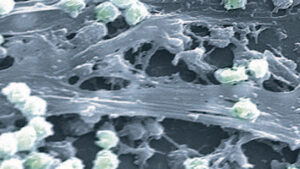Nanoparticles Used For pH-Activated Biofilm Control
In a study in Nature Communications, researchers Hyun (Michel) Koo, DDS, MS, PhD, a professor at the University of Pennsylvania School of Dental Medicine, and David Cormode, PhD, of Penn’s Perelman School of Medicine and School of Engineering and Applied Science, used catalytic nanoparticles to effectively disrupt oral biofilm in an experimental tooth material and an animal model that mimics early childhood caries.

In a study in Nature Communications, researchers Hyun (Michel) Koo, DDS, MS, PhD, a professor at the University of Pennsylvania School of Dental Medicine, and David Cormode, PhD, of Penn’s Perelman School of Medicine and School of Engineering and Applied Science, used catalytic nanoparticles to effectively disrupt oral biofilm in an experimental tooth material and an animal model that mimics early childhood caries.
The nanoparticles break up plaque through a unique pH-activated antibiofilm mechanism. Reportedly, this therapy is able to precisely target pathogenic biofilm without harming the surrounding oral tissues or microbiota. “We used plaque samples from caries-active subjects to reconstruct these highly pathogenic biofilms on human tooth enamel,” says Koo. “This simulation showed that our treatment not only disrupts biofilm, but also prevents mineral destruction of the tooth.”
Koo, who is working to test clinical efficacy, notes that incorporating these iron-containing nanoparticles in a mouthrinse or toothpaste could be a cost-effective way to significantly improve their effectiveness.
From Decisions in Dentistry. September 2018;4(9):8.


